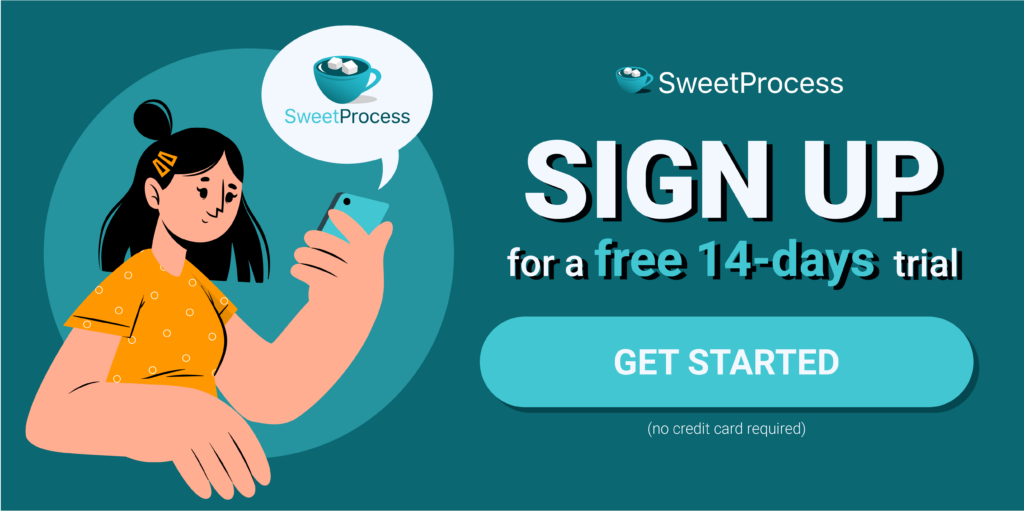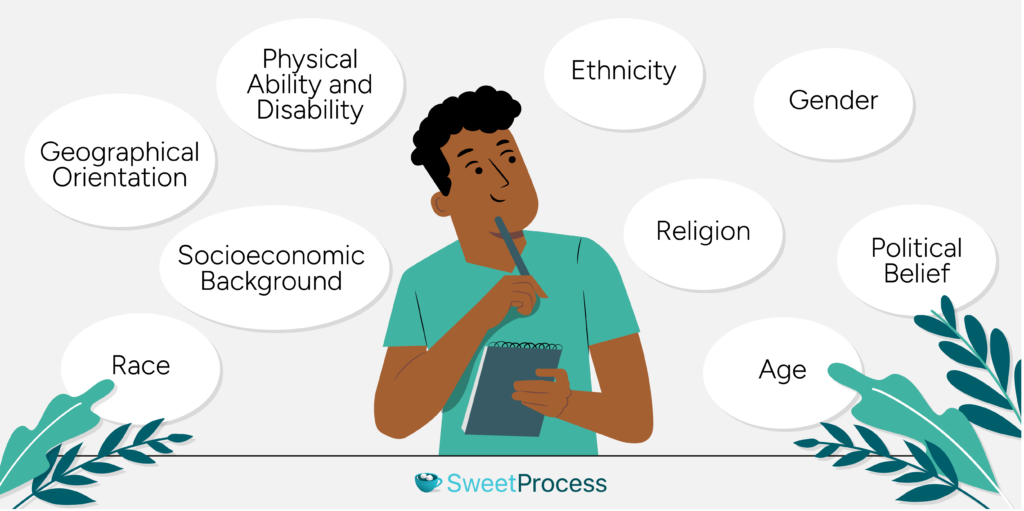Last Updated on February 7, 2025 by Owen McGab Enaohwo
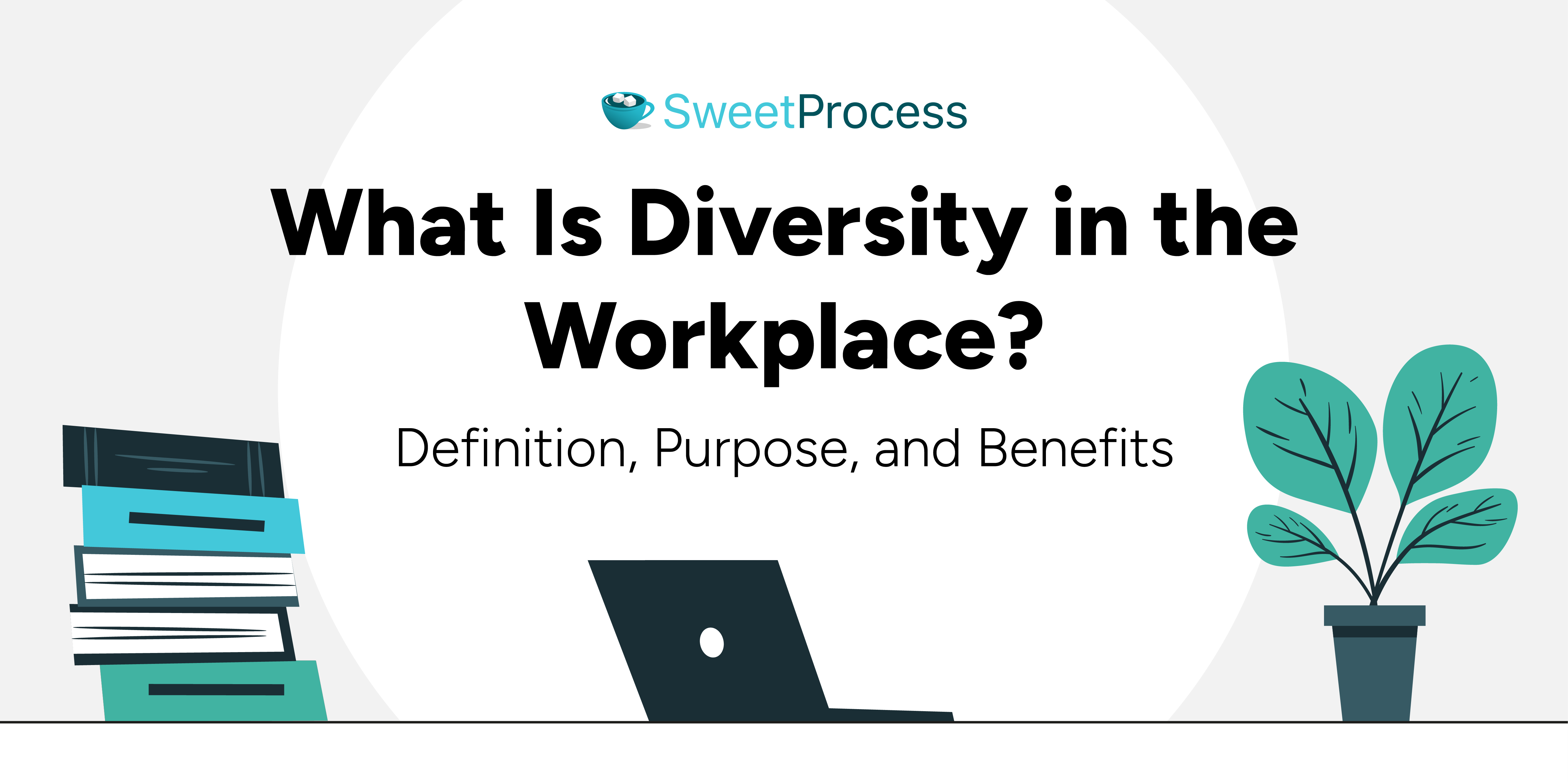
Have you ever wondered why some businesses thrive with fresh ideas while others struggle to innovate? The answer might lie in the diversity of their teams. As the world becomes more globalized, diversity in the workplace becomes a crucial element of successful business operations.
A survey by the Pew Research Center shows that a majority of employees, about 61%, have encountered diversity measures in their workplace, especially during promotions, hiring, and salary payments.
More companies are investing in diverse teams because they bring a wealth of approaches, enhancing creativity and problem-solving capabilities. Additionally, a diverse workforce can better understand and meet the needs of different customers, leading to increased customer satisfaction.
While some organizations have successfully implemented policies that embrace diversity in the workplace, others are still encountering challenges that affect their operations. So, how can companies create, manage, or improve their work environment to be more inclusive?
In this article, we’ll explore the concept of diversity in the workplace, its purpose, and the many advantages it brings to businesses.
Your organization needs a tool to effectively manage diversity in the workplace. SweetProcess is the go-to software. Sign up for a 14-day SweetProcess free trial. No credit card is required.
Table of Contents
What Is Diversity in the Workplace?
Why Is Diversity so Important in the Workplace?
4 Common Types of Workplace Diversity
9 Ways to Improve and Promote Workplace Diversity and Inclusion
How to Manage Diversity in the Workplace Using SweetProcess
9 Benefits of Diversity in the Workplace
9 Examples of Diversity in the Workplace
7 Real-Life Examples of Companies Promoting Diversity in the Workplace
Common Challenges Facing Diversity in the Workplace
Improve Your Workplace Diversity Using SweetProcess
What Is Diversity in the Workplace?

Diversity in the workplace is the inclusion of individuals from a wide range of backgrounds and characteristics. It caters to differences in race, gender, age, sexual orientation, cultural background, physical abilities, and life experiences. It also involves creating an environment where various perspectives are respected and valued.
Companies that embrace diversity can tap into a rich well of ideas, skills, and approaches. This can lead to better problem-solving and stronger decision-making within the organization.
Imagine a tech company developing a new fitness app. A diverse team on this project might include:
- A young programmer who grew up playing competitive sports.
- A seasoned developer with a background in physical therapy.
- A data analyst with a disability who uses the app themselves.
- A marketing specialist from a different cultural background with unique insights into user preferences.
Once you bring together these diverse perspectives, the team can create a more well-rounded app that caters to a wider range of users and addresses potential accessibility issues from the start.
Why Is Diversity so Important in the Workplace?

Workplace diversity is good for your company. It impacts your performance, culture, and long-term success. Since today’s global market is quite competitive, you need to develop innovative products and creative solutions that meet your customers’ needs. A diverse team can help you achieve these, thanks to the different perspectives and experiences.
Once you start making room for your employees to coexist, you pave the way for more revenue. However, this shouldn’t be limited to employees; it should also cover the entire organizational structure, including the board of directors and leaders who make policy decisions.
A McKinsey report shows that organizations with more diverse boards of directors can perform better financially. Therefore, you have more to gain when you have equitable representation across the board.
4 Common Types of Workplace Diversity
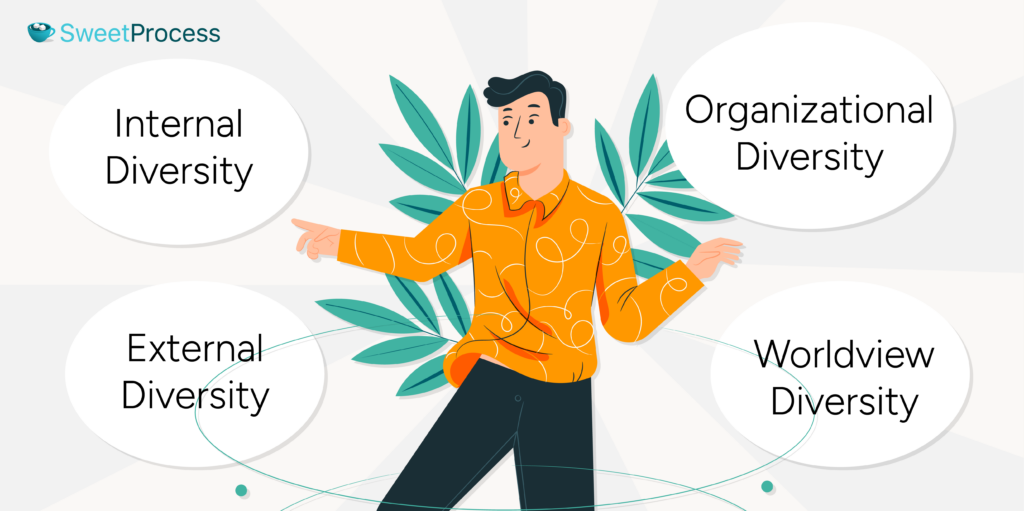
What makes a workplace truly dynamic and inclusive? It’s the blend of diverse individuals. Understanding the different types of workplace diversity will help your company unlock the full potential of your teams. While some are visible and constant, others may change with time. Here are the different types of diversity.
Internal Diversity
These are characteristics that an individual is born with. They include race, ethnicity, age, gender, disabilities, and sexual orientation. The Universal Declaration of Human Rights protects most of these traits.
External Diversity
External diversity covers attributes that individuals acquire throughout their lives, which can be influenced by personal choices and experiences. These include education, marital status, parental status, socio-economic status, and religious beliefs. They are described as external because they change with time.
Organizational Diversity
To boost organizational effectiveness, companies organize and assign their operations to different departments and roles. You also need to implement organizational diversity, which refers to differences in a company’s roles, functions, and departments. This includes diversity in job functions, management levels, and work locations.
Worldview Diversity
In most cases, your employees will not hold the same beliefs. Worldview diversity includes individuals’ different perspectives and belief systems based on their cultural backgrounds and life experiences. This type of diversity is reflected in how people approach problems, make decisions, tolerate risks, and interact with others.
9 Ways to Improve and Promote Workplace Diversity and Inclusion

Imagine walking into an office where employees from various backgrounds, different cultures, and life experiences collaborate seamlessly. The atmosphere is vibrant, ideas flow freely, and everyone feels valued and empowered. This scenario isn’t just an idealistic vision but a reality for companies that prioritize diversity and inclusion.
However, not all companies have a proper diversity policy. If this is you, you shouldn’t shy away from creating a new diversity initiative or improving the existing one.
So, what are the things that you must consider when scaling up or promoting diversity in your workplace? Let’s dive into it.
Develop Inclusive Hiring Practices
According to Glassdoor, 76% of job seekers consider the diversity of the workforce when evaluating job offers. Therefore, as you hire new employees, it’s also important to go beyond traditional resumes.
Start with your recruitment process to ensure it attracts many candidates. This can be achieved by:
- Using diverse job boards.
- Writing inclusive job descriptions by emphasizing that the company is committed to hiring employees regardless of their background or disability.
- Utilizing diverse interview panels
- Implementing blind recruitment techniques to reduce bias.
Additionally, you can organize unconscious bias training for hiring managers to help the company hire the best teams.
Build an Inclusive Culture and Uphold It
What is your current diversity environment?
Is every team member aware of the workplace policies and procedures that govern inclusion?
These questions can guide you in ensuring that diversity is embedded in everyday practice. To improve the processes, you can conduct regular diversity training sessions for all employees to increase awareness. Furthermore, encourage open dialogue through forums, workshops, and cultural celebrations highlighting different perspectives.
Inclusive Leadership
Leaders set the tone for all operations. Good managers should lead from the front by championing diversity and inclusion in all their decisions. This way, they can hold the entire team accountable and make better decisions. They should also actively listen to employee concerns and create opportunities for everyone’s professional development.
Additionally, it’s important to have a diverse leadership team to keep the employees motivated. Employees who feel well-represented are more likely to feel comfortable in the organization.
Make Diversity and Inclusion a Team Effort
Don’t relegate diversity to the human resources department. Instead, integrate it into all aspects of the organization. You can establish diversity committees or employee resource groups (ERGs). These groups provide platforms for employees to share experiences, discuss challenges, and propose solutions to promote inclusivity within the organization.
You can also encourage employees to collaborate and participate in diversity-related initiatives. For instance, a company like Microsoft has nine ERGs that employees can use to connect and find critical support.
Foster Vulnerability and Open Dialogue
When you have a diverse team, you must create a safe environment where every employee feels comfortable sharing their perspectives related to diversity.
For starters, leaders should model vulnerability by acknowledging their own biases and having open dialogue on sensitive topics. This approach encourages employees to follow suit. It’s also essential to regularly solicit feedback from employees to assess whether the inclusivity efforts are bearing fruit or if there are issues.
Diversify the Talent Pool
If you are struggling to diversify your employees, consider expanding your recruitment efforts to attract more candidates from different backgrounds. You can also partner with universities, professional organizations, and community groups that support underrepresented populations.
If this approach is not enough, add some outreach programs and scholarships that will attract diverse talent to your company.
Ensure Equal Compensation and Opportunities
How do you pay your team members? Does everyone receive similar benefits and fair pay regardless of their background?
While the pay gap has changed over the years, some key disparities remain. Start by conducting regular audits that identify pay gaps in your departments. You can use this information to address existing disparities.
These efforts shouldn’t stop here. Provide equitable opportunities for career development, mentorship, and advancement based on merit and potential. Therefore, you need to establish transparent promotion processes that recognize and reward diverse talent.
Address Issues Promptly and Transparently
If bias or discrimination occurs, acknowledge them promptly and take corrective action. This demonstrates a commitment to ongoing improvement.
Write clear policies and procedures for addressing discrimination, harassment, and other diversity-related issues. This will encourage employees to report incidents without fear of retaliation. Additionally, a good policy will ensure that investigations are thorough, fair, and conducted with sensitivity.
Set and Track Diversity Goals
How will you know whether your diversity efforts are successful? You need to have trackable goals. As you develop the company’s strategic objectives, include measurable diversity and inclusion goals.
For instance, if your goal is to achieve gender parity in leadership roles within the next five years, you can implement a hiring, training, and transparent promotion plan to guide you. You can also continuously monitor the percentage of women in leadership roles annually and compare against the baseline to track progress toward the goal.
How to Manage Diversity in the Workplace Using SweetProcess

SweetProcess is a cloud-based software designed to streamline and document standard operating procedures (SOPs) within organizations. It enables businesses to easily create, organize, and share procedural documentation with team members.
With SweetProcess, companies can clarify workflows, improve consistency in operations, and enhance training processes by providing clear, step-by-step instructions for tasks and procedures. The software offers capabilities such as task management, version control, and integration with other tools. It is a valuable resource for businesses looking to increase efficiency, maintain quality standards, and scale operations.
These features make SweetProcess an ideal tool for managing diversity policies and processes. Here’s how:
Create a Company Policy Manually and Using AI
With a policy, you can define the diversity guidelines for your company. SweetProcess allows you to create these policies manually or using AI.
Here’s how to create the diversity policy manually:
- Log in to your account.
- Select “More.”

- Click “Policies”

- Tap “Create Policy.”

- Include the title and choose the specific teams to assign the policy to.
- Click “Continue.”
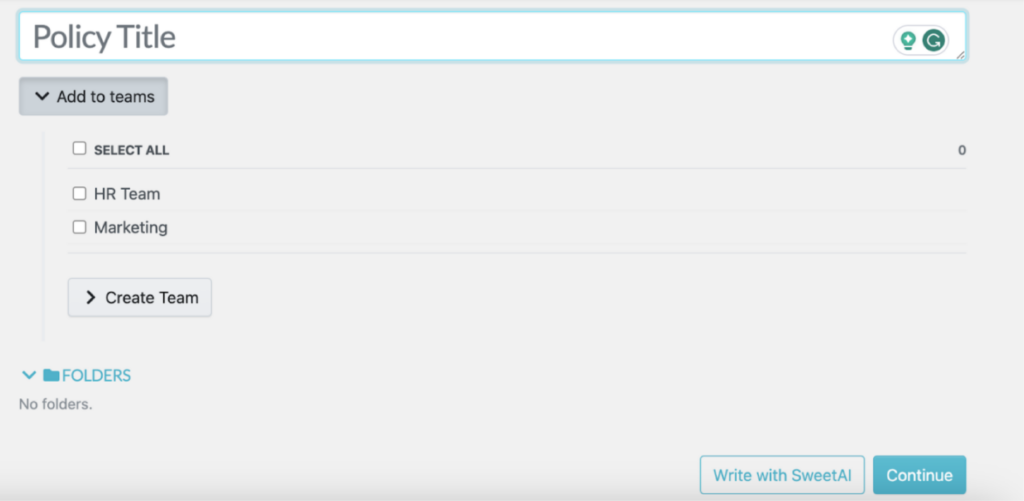
- Draft the policy manually and add tags.

- Save the changes when done.
SweetProcess allows you to include approval permissions to provide access to the right team members.
Alternatively, you can rely on SweetAI to draft the policy. Follow these steps:
- Follow similar steps to create a new policy as listed above.
- Add the policy title and click “Write with SweetAI.”

- Alternatively, click “Continue” and key in the policy title on the next tab.

- SweetAI will generate your diversity policy within minutes.
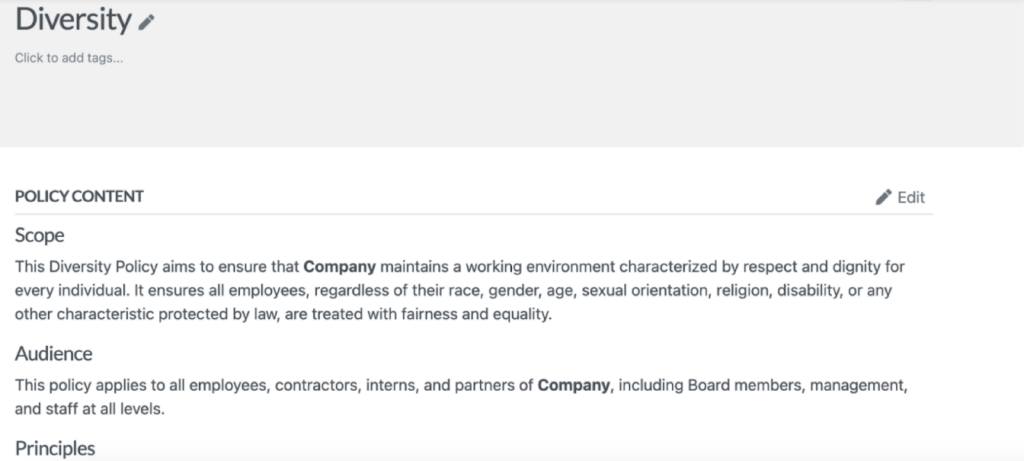
Manage Your Company’s Policies Effectively
Once you draft your policies, you can manage them easily via SweetProcess. This tool allows you to edit, assign, and make any changes to the diversity policy.
If you need to edit a specific policy, tap “Policies” to start the process. Each policy has three dots on the right. Click on that to either edit, duplicate, share, add tags, assign to teams, export, or delete.
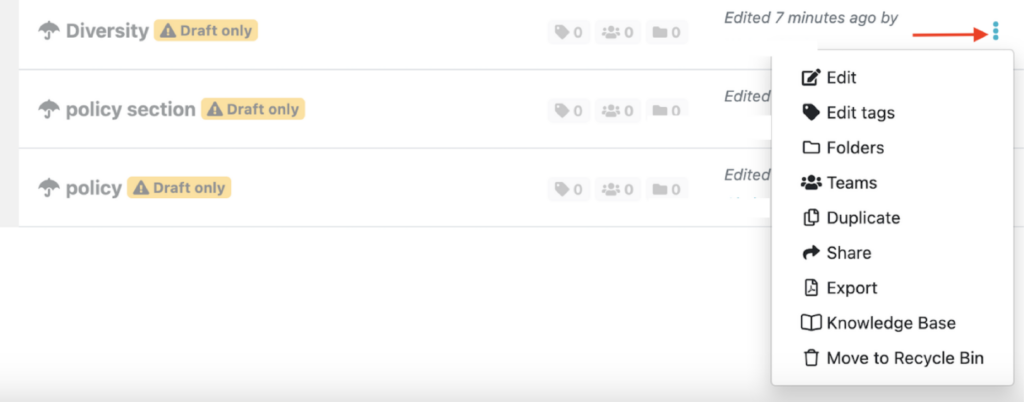
Create a Process for Your Company
If you need a process to help with your diversity plans, here’s how to use SweetProcess to create one:
- Select the “Processes” tab.
- Click “Create Process.”

- Add a title.
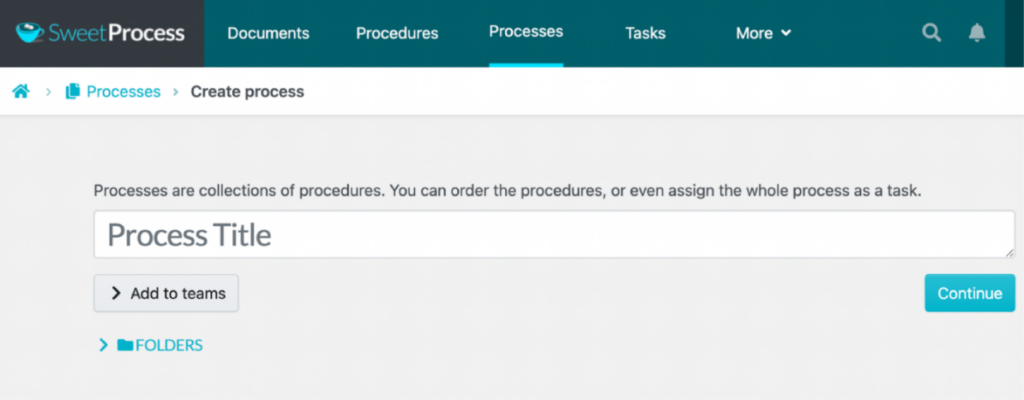
To make the process comprehensive, add tags, videos, and images. These will be handy when conducting diversity training within the organization.
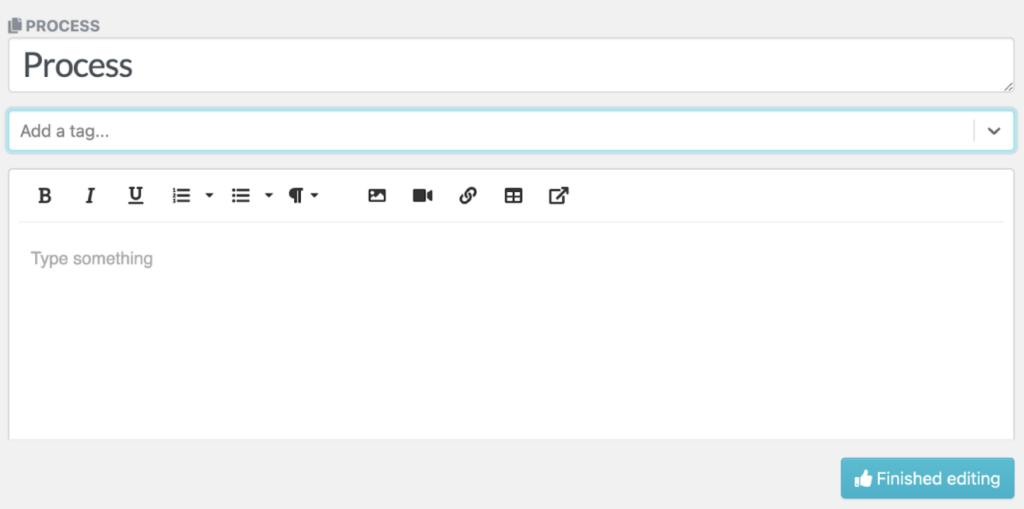
Manage Your Business Processes
To manage the processes, open the “Processes” tab on the main menu and select the one you need.
If you identify any gaps, you can edit the process to make changes. You can also view the versions on your left-hand side by clicking on the clock icon.
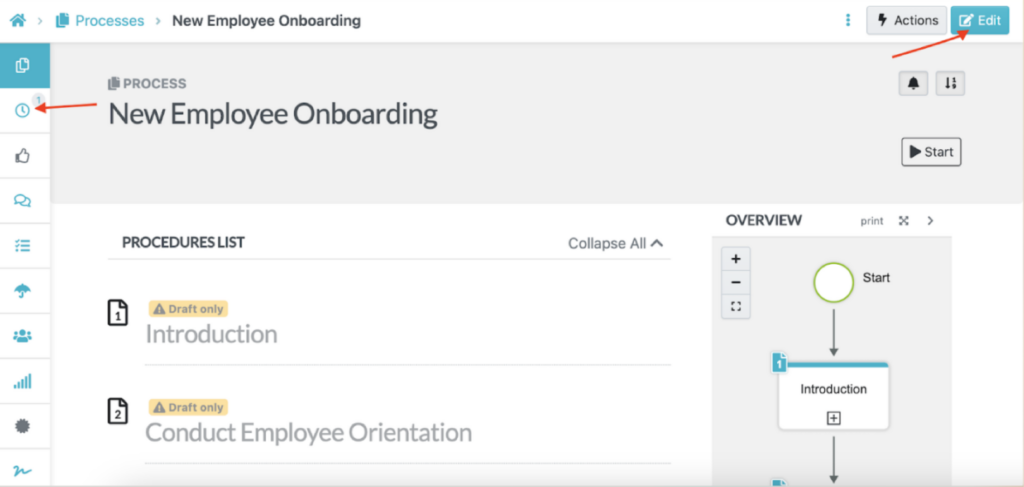
Collaborate With Team Members Seamlessly
SweetProcess is an efficient collaborative tool. It allows you to share policies and processes to ensure you are on the same page regarding diversity. It can also be used to assign and monitor tasks during training, which eases collaboration.
To assign tasks:
- Click “Tasks.”
- Select “Assign Tasks.”

You can select the team members to whom you want to assign tasks and add their names, task names, due dates, and times.
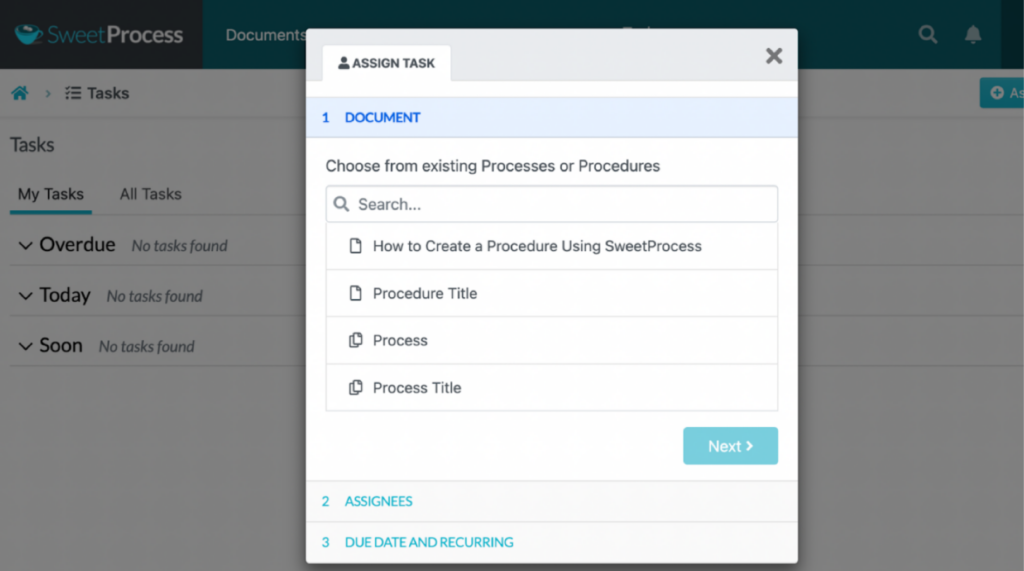
When the tasks are assigned, you can monitor each employee’s progress and pending tasks. Open “All Tasks” to view all the information.
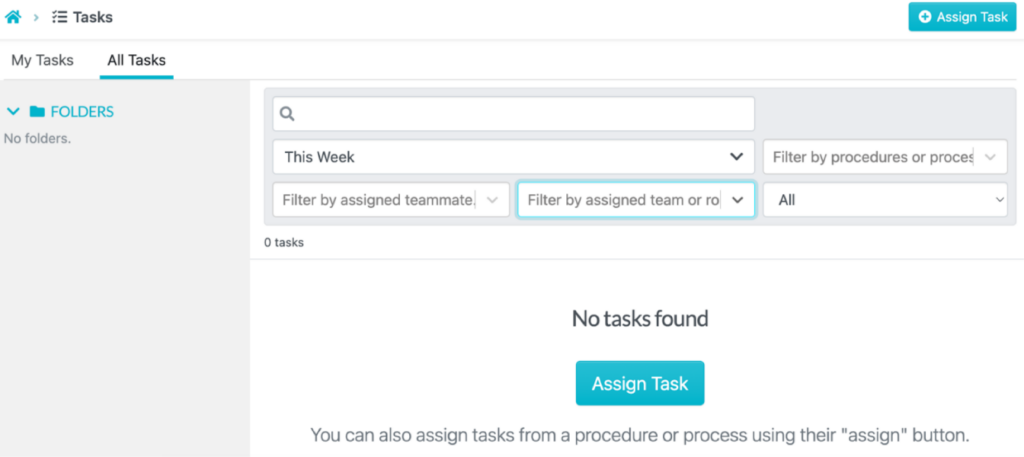
Additionally, SweetProcess has a knowledge base that everyone can access. You can add all the documentation on diversity to this knowledge base to boost collaboration. Here’s how to create one:
- Log in to your account.
- Click “More.”
- Select “Knowledge Bases.”
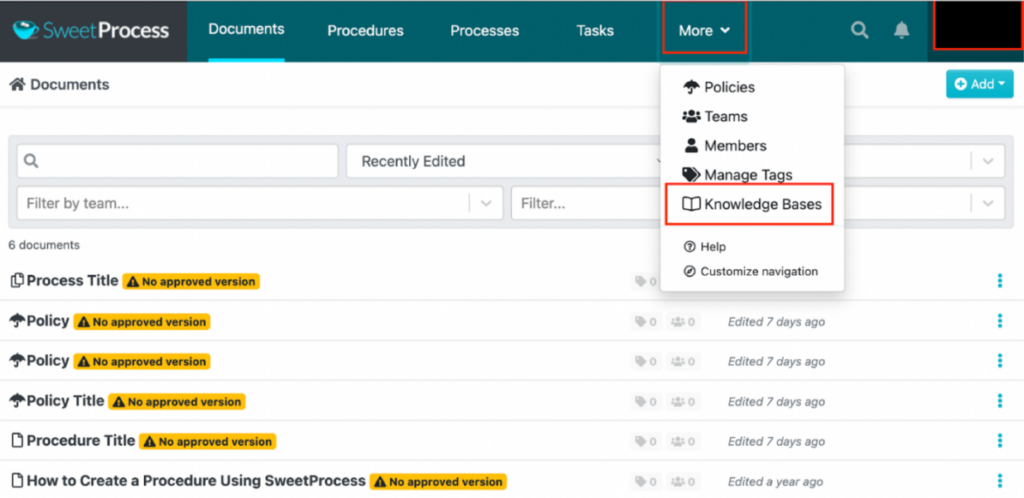
Add control permissions and choose a theme for your knowledge base.
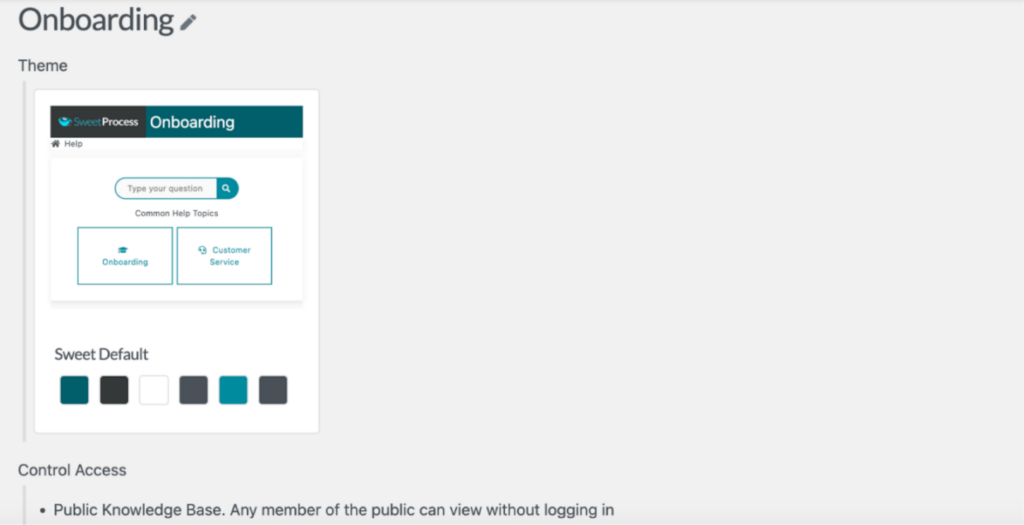
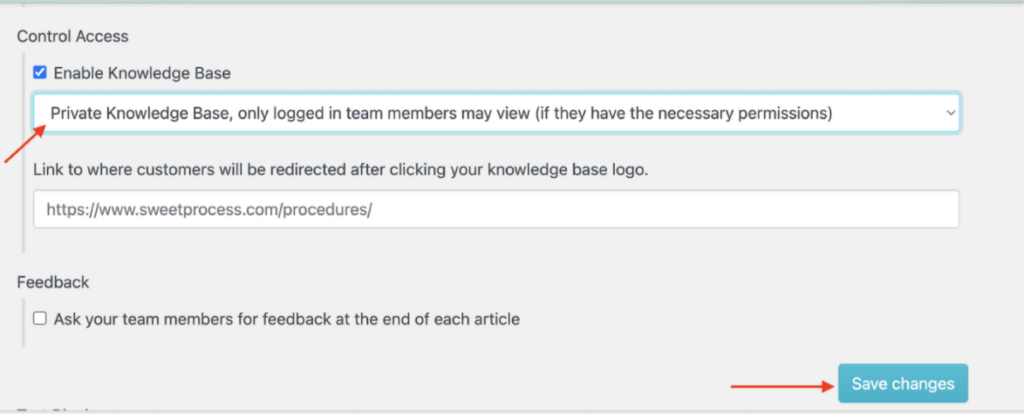
If the documentation is meant for external stakeholders, you can include a public URL linking to the knowledge base.
Want to start using SweetProcess? Here are some companies that have used this tool to manage their processes and policies.
Ted Fogliani, the CEO of ShipCalm, has always had processes to run his company. However, once he began operating the organization, he couldn’t find an effective tool that met all his standards. As the number of customers increased, it became harder to manage the company due to a lack of an efficient workflow system.
His team was overstretched; therefore, they couldn’t execute the tasks effectively.
His search led him to SweetProcess. He shares, “The learning curve on SweetProcess is the number of hours or days. It’s not a number of weeks, which is rare for a software implementation…. Because a lot of people can use SweetProcess in my environment, most people can use those tools for the onboarding process, and so it’s a very simple integration for us.”
Ted and the team can build a centralized knowledge base, document processes, and train employees from one tool.
Another good example is Don Houk, the president of Next7 IT. The team was already using Microsoft Word to document processes. However, this approach was inefficient because the documentation was getting lost and mixed up easily, leading to disorganization. Additionally, it was difficult to keep employees accountable without a proper system.
Don started looking for a workflow system to help the company boost performance and document processes. Since the company switched all these processes to SweetProcess, they closed the knowledge gap. The employees are also now more proactive and have streamlined operations. Additionally, they can now use the tool for onboarding and sharing information during training.
Create standardized, bias-free hiring processes with SweetProcess. Start your 14-day free trial of SweetProcess now to improve the inclusivity of your recruitment efforts.
9 Benefits of Diversity in the Workplace

Diversity in any organization is a smart business decision. It’s become a necessity for a thriving, modern organization. Here are the key advantages your company can get from creating a diverse workplace.
Broader Range of Skills and Knowledge
A diverse workforce brings together individuals with varied backgrounds, experiences, and expertise. These differences in the workplace make team members draw inspiration from one another to develop newer ideas. You can use the collective wealth of skills and knowledge to tackle complex challenges and achieve organizational goals.
Imagine an engineering team with members from different educational backgrounds: one strong in mechanical engineering, another with a background in computer science. Together, they can create a more innovative and well-rounded solution.
Enhanced Problem-Solving
When people with different viewpoints come together, they challenge assumptions and offer fresh perspectives. This leads to a more dynamic problem-solving process and the identification of solutions that a homogenous team might have missed. For instance, a marketing team with a mix of cultural backgrounds might brainstorm a wider range of marketing strategies to reach a global audience.
Expanded Market Reach
Let’s say you run a clothing company that wants to introduce a new line in different markets. You’ll need to understand the different cultural preferences to tailor the products for the market segments. Therefore, if you had employees representing different body types and ethnicities, you’d be better equipped to design clothes that appeal to a wider range of customers.
This way, you can develop marketing strategies that resonate with diverse market segments. This expanded market reach can drive growth and improve customer satisfaction.
Improved Decision-Making
You’ll tend to make better decisions with diverse teams due to their varied perspectives. When team members from different backgrounds contribute to the decision-making process, they challenge assumptions and offer different viewpoints, leading to more well-rounded and effective decisions. This is particularly important for companies navigating complex challenges or entering new markets.
Increased Employee Engagement and Retention
Approximately 80% of employees want to work for organizations that value diversity, equity, and inclusion (DEI). This is because an inclusive workplace where diversity is valued fosters higher levels of employee engagement and satisfaction. Employees who feel included are more likely to be motivated, productive, and loyal to the organization. This, in turn, reduces employee turnover rates and helps retain top talent.
Increased Creativity and Innovation
Want to inject some creative ideas into your organization? Consider hiring a diverse team. Diversity in the workplace fuels creativity because everyone has different viewpoints and ideas on how to execute projects. This approach is the best option if you want to challenge conventional thinking and introduce creative solutions that will keep the company ahead of the curve.
Decreased Groupthink at Work
Groupthink is a major pitfall in any business. It can cause team members and their managers to conform to the same way of thinking without evaluating the alternatives. When a homogenous team prioritizes consensus over critical thinking, this leads to poor decision-making. However, with diverse teams, your employees are more likely to explore alternative viewpoints. This healthy debate and scrutiny result in more robust solutions.
Improved Financial Performance
There’s no doubt that there’s a strong correlation between workplace diversity and increased profits. Therefore, your organization can benefit and improve its financial performance with the right team in place. This is because companies with a diverse workforce tend to be more innovative, have better decision-making, and reach a wider market, all of which contribute to stronger financial results.
Enhanced Employer Brand Reputation
A commitment to diversity enhances an organization’s reputation as an employer of choice. Companies known for their inclusive culture attract top talent and are viewed favorably by customers, partners, and investors. Therefore, implementing diversity processes is a good choice if you want to gain a competitive edge.
9 Examples of Diversity in the Workplace
While diversity is used as a blanket term, it covers several differences among your employees. Understanding these differences is essential to building a more dynamic and inclusive organizational culture. Here are nine key examples of diversity that organizations should recognize and celebrate.
Ethnicity
This refers to a person’s cultural heritage and background. A diverse team might include people from different countries with ancestral ties to various regions of the world. This diversity of backgrounds brings a wealth of cultural perspectives and experiences to the table.
Ethnicity differs from race because it covers elements such as religion, ancestry, language, and traditions.
Gender
You also need to consider your employees’ gender identity. In modern workplace culture, gender diversity goes beyond the binary of male and female. It includes people who identify as transgender, non-binary, genderfluid, or genderqueer. Having a workforce that reflects the gender spectrum breaks down stereotypes and encourages equality in opportunities and treatment.
Religion
Every team member has religious beliefs that define them. Therefore, as an organization, you need to accommodate employees of various religious beliefs and practices. This can include providing flexible work schedules for religious observances, creating prayer spaces, and promoting a culture of respect for different religious customs.
Political Belief
While political discussions might not be appropriate in all work settings, it is important to acknowledge that employees have diverse political viewpoints. Political diversity means respecting different political opinions. Encouraging open and respectful discussions about political beliefs can enhance understanding and reduce polarization. It also promotes a culture where employees feel safe expressing their views without fear of discrimination.
Age
Most organizations have multigenerational teams in their workforce. Age diversity involves having a workforce that includes a range of ages, from younger employees just starting their careers to older, more experienced workers. Forbes data shows that the younger generation, millennials, are set to be about 75% of the workforce by 2025, and Gen Z is joining different industries in large numbers.
Younger employees may offer fresh ideas and technological savvy, while older employees can provide mentorship and institutional knowledge. This leads to a more balanced perspective and a wider range of skills.
Race
Racial diversity is a fundamental aspect of workplace inclusivity. Promoting racial equality in the workplace can help address inequalities and create a more inclusive environment.
While race is primarily associated with physical characteristics, such as skin color, ethnicity covers other cultural factors, such as nationality, culture, and language.
In the long run, the company will benefit from richer cultural exchanges that contribute to innovation.
Physical Ability and Disability
Eighty percent of disabilities are not outwardly visible. Therefore, as you consider these elements, you need to also consider employees with disorders such as developmental differences, long COVID, depression, heart disease, and neurological disorders.
A diverse workplace should have fair adjustments that help employees with disabilities integrate easily. This can involve providing assistive technologies, accessible facilities, mental health support, and flexible work arrangements.
Socioeconomic Background
Employees come from different socioeconomic backgrounds. These experiences shape their work ethic, communication styles, and problem-solving approaches. Socioeconomic diversity involves recognizing and valuing employees despite their backgrounds. One of the ways to achieve this form of diversity is by hiring team members from disadvantaged backgrounds through scholarships, internships, and fair hiring practices.
Geographical Orientation
As of 2023, about 12.7% of full-time team members work primarily from home, while 28.2% are on a hybrid model. If your employees are in different regions, cities, or countries, you must factor in this diversity. Geographical diversity can lead to a broader understanding of global markets, cultural practices, and regional preferences.
By incorporating a wide range of regional insights, it can also enhance a company’s ability to operate and compete in a globalized economy.
7 Real-Life Examples of Companies Promoting Diversity in the Workplace
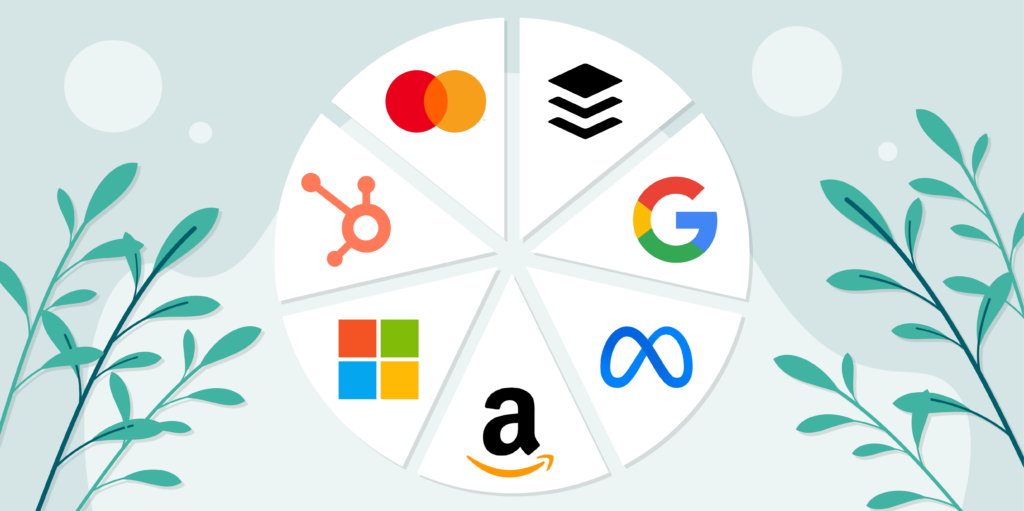
Many leading companies are recognizing the power of diversity and taking concrete steps to create inclusive workplaces. Here are a few inspiring examples.
Google has a long-standing commitment to diversity. For instance, they offer unconscious bias training for employees. They also have established employee resource groups (ERGs) for different communities within the company such as Black Googlers Network and Women@Google. These groups provide support, mentorship, and networking opportunities for employees.
Furthermore, the company has implemented various initiatives, including its annual “Google Diversity Annual Report,” which provides transparency on its progress.
Facebook (Meta)
Meta, formerly Facebook, is committed to creating a diverse and inclusive workplace. The company’s annual diversity report highlights its efforts and progress in increasing representation across different demographics. Facebook has also implemented initiatives like:
- The Diverse Slate Approach ensures that various candidates are considered for every open position.
- Facebook also supports various ERGs, including those for LGBTQ+ employees and veterans, to promote a sense of belonging.
- Facebook University helps to increase access and equal opportunity for underrepresented students interested in business, software engineering, and analytics.
They also hold unconscious bias training sessions to help diverse employees thrive.
Amazon
Amazon focuses on diversity through its many programs and initiatives. The company has set ambitious goals to increase diversity in its workforce, particularly in leadership roles. For instance, the company launched the Amazon Future Engineer program to provide computer science education to students from underserved communities. Additionally, Amazon’s affinity groups, such as Women at Amazon and Black Employee Network, play a crucial role in fostering an inclusive work environment.
Microsoft
Microsoft also actively promotes diversity and inclusion through its comprehensive strategies and programs. The company’s Global Diversity and Inclusion strategy includes efforts to increase the representation of women and minorities in technical and leadership roles. Microsoft also emphasizes inclusive hiring practices and provides extensive training on unconscious bias. ERGs, such as Blacks at Microsoft and Women at Microsoft, support the company’s diversity goals and provide valuable networking opportunities.
HubSpot
HubSpot is another company known for its strong commitment to diversity and inclusion. The company regularly publishes diversity data and has implemented initiatives to promote an inclusive culture. HubSpot’s Culture Code outlines its commitment to diversity and includes measures such as inclusive hiring practices and the creation of diverse interview panels. The company also supports employee resource groups like People of Color at HubSpot and Women@HubSpot.
Mastercard
Mastercard is also making significant strides in promoting diversity and inclusion within its workforce. Some of their diversity initiatives include:
- A Global Inclusion & Diversity Council to drive its initiatives and measure progress.
- Mastercard’s Girls4Tech program encourages young girls to pursue careers in STEM fields, addressing gender diversity from an early age.
- Mastercard’s Business Resource Groups (BRGs), such as the Women’s Leadership Network and PRIDE, play a key role in supporting diverse employees.
Additionally, the company strongly advocates for pay equity globally. They also invest heavily in leadership development programs for women and minorities, helping them advance their careers within the company.
Buffer
Buffer has gained recognition for its commitment to transparency and diversity. Buffer publishes its diversity data openly and actively works to improve representation within the company. The company has implemented remote work policies to attract a more diverse talent pool and offers flexible working arrangements to accommodate different needs. Buffer also conducts regular diversity and inclusion training to ensure all team members feel valued and respected.
Common Challenges Facing Diversity in the Workplace

While the benefits of diversity in the workplace are widely recognized, implementing and sustaining diversity initiatives comes with its own set of hurdles. Here are some of the common obstacles organizations face.
Difficulties in Immigration and Employment Laws
For your organizational development efforts to be successful, you need to navigate the complexities of immigration and employment laws. If you are hiring international talent, you might encounter challenges like complex visa regulations and varying employment laws across countries.
Additionally, changes in immigration policies can disrupt workforce planning and limit the ability to hire the best candidates from a global talent pool. Companies must be aware of legal requirements and invest in legal expertise to ensure compliance.
Combating Discrimination, Complaints, and Legal Actions
Even with the best intentions, cases of bias can still creep into the workplace. For instance, microaggressions, unfair treatment, and a lack of inclusivity in your organization can lead to employee complaints and even legal action. Legal cases can be costly and damaging to a company’s reputation.
Additionally, addressing complaints and legal actions related to discrimination requires robust policies, effective training programs, and a culture of zero tolerance. Organizations must implement comprehensive anti-discrimination policies, provide channels for reporting issues, and ensure that all complaints are handled promptly.
Varying Work Styles Leading to Conflicts
As you hire new employees, everyone comes with a different work style. Additionally, every employee might have a different approach to problem-solving. While this diversity can drive innovation, it can also lead to misunderstandings and conflicts. As the manager or business owner, you have to find ways to merge these styles.
This also includes identifying and mediating these differences to prevent them from affecting team cohesion and productivity.
Stakeholders’ Resistance to Change
When was the last time you introduced changes in the company?
Introducing diversity initiatives can sometimes meet resistance from stakeholders accustomed to the status quo. This resistance can stem from unconscious biases, fear of change, or concerns about the impact on the performance.
Overcoming this resistance requires clear communication and solid leadership about the benefits of diversity. You also need to involve all the stakeholders in the planning and implementing of diversity initiatives.
Improve Your Workplace Diversity Using SweetProcess

Creating a diverse and inclusive workplace is a smart business decision. This is because diverse teams bring a wider range of skills and experiences to the table. Once organizations tap into this inclusive environment, it enhances creativity among team members, improves decision-making, and boosts the bottom line.
However, creating a truly inclusive environment requires ongoing effort. At SweetProcess, we understand the importance of clear communication and streamlined processes in managing a diverse team. Our user-friendly platform allows you to document onboarding procedures, create inclusive training materials, and manage communication channels effectively.
Ready to unlock the full potential of your diverse workforce? Sign up for a free trial of SweetProcess today and build a thriving and successful workplace for everyone.
